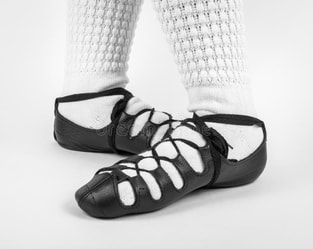 Last time, we took a look at the importance not only of turnout for the sake of technique and aesthetics, but for the safety of every dancer. This, of course, extends to other aspects of technique, including: crossing. Whether you’ve been dancing one year or twenty, crossing is one of the most basic techniques to master, as it’s the beginning and end position to any Irish dance move you might perform—one leg in front of the other. To determine what state your crossing technique is currently in, first turn out your feet (which we covered last week!) Then, starting with your heels still together, move your right leg in front of your leg without shifting the position of your turned-out foot, knee, or hip. The first goal is get your right heel touching your left toes. As you improve your turn out, the next goal would be getting your right toes to touch your left heel in the same position (with your right foot still in front.) This is the ultimate crossing goal in the Beginner and Early Intermediate levels, along with getting that first progression in every movement! As you move on to the highest grades of Irish dance, you’ll want to increase your crossing ability. To do this, you’ll want to keep moving your already crossed feet further apart—your left leg further to the right and your right leg further to the left—until you can’t move them any further. The goal for the best possible technique in Irish dance would be as much space between your shins as possible while you’re in a crossed position. However, it’s important to keep body alignment in mind when crossing, as the act of crossing can often lead to dancer to be facing diagonally instead of straight ahead. If this is happening, you want to correct yourself into a less turned out or less crossed position where you belly button is facing forward. A study of dancers across disciplines from the Clinics in Podiatric Medicine determined that 53% of dance-related injuries are of the ankle or foot (with a higher proportion in Irish dancers--83% in this specific study) citing lack of proper body alignment as one of the primary sources of said injuries. Crossing your feet may seem like no big deal, but as all jumps in Irish dance are expected to begin and end in this position, correct crossing technique is imperative to a dancer’s health and safety. Research from BYU in 2017 asserts that Irish dancers land with a force of 4.5-6 times their body weight, making proper technique while jumping one of the easiest ways to avoid injury. With the effects of dance shoes across disciplines being a relatively new area of study in sports medicine, mitigating this force with proper technique becomes paramount. There are many exercises to help improve your crossing technique, and some of Miss Courtney’s favorites include cross walks up to the mirror (to be able to see your alignment all the better—make sure to always practice with proper technique, it’s the only way to improve!), as well as floor butterflies to increase the strength in your inner thighs and glutes. Take a look at our last post in this series to see a few exercises that will help increase your turnout, too—turnout is important in every aspect of Irish dance, including crossing! The better your turnout, the better technique in your crossing. Miss Courtney also recommends mental cues while dancing to help you remember to both start and end in the correct position, such as “keep only one knee showing” or “keep space between your shins.” While the longer you dance, the more muscle-memory will kick in (read more about movement memory here!), it’s always good to have the mental cues tied to those muscle memories to reinforce this basic tenet of technique if you ever get flustered. It could save you from injury, and will wow the adjudicators! Tune in next week for another technique review—all about posture! This post is part of a series. Take a look at our last technique review, all about turnout, here. Also: check out the blog every Monday and Thursday for more posts about Irish history, dance culture, community news, and spotlights on our dancers, staff, and families—among other fun projects! And don’t forget to dance along with us on both Facebook and Instagram.
0 Comments
Your comment will be posted after it is approved.
Leave a Reply. |
SRL NewsFind all of our latest news on our Scoil Rince Luimni Facebook page! Categories
All
Archives
August 2022
|
 RSS Feed
RSS Feed